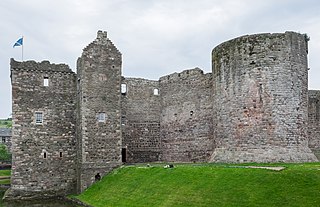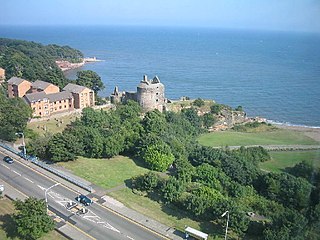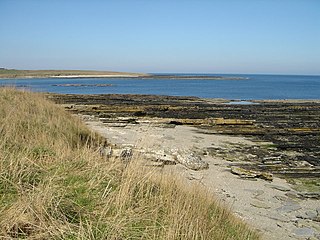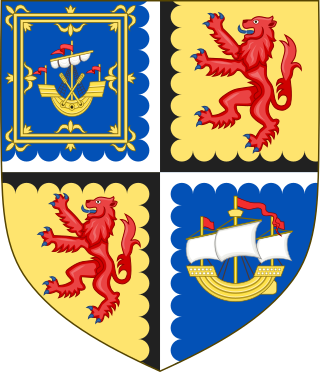
The Castle of Mey is located in Caithness, on the north coast of Scotland, about 6 miles (10 km) west of John o' Groats. In fine weather there are views from the castle north to the Orkney Islands.

Thurso is a town and former burgh on the north coast of the Highland council area of Scotland. Situated in the historical County of Caithness, it is the northernmost town on the island of Great Britain. From a latitudinal standpoint, Thurso is located further north than the southernmost point of Norway and in addition lies more than 500 miles (800 km) north of London.

Caithness is a historic county, registration county and lieutenancy area of Scotland.

Earl of Caithness is a title that has been created several times in the Peerage of Scotland, and it has a very complex history. Its first grant, in the modern sense as to have been counted in strict lists of peerages, is now generally held to have taken place in favor of Maol Íosa V, Earl of Strathearn, in 1334, although in the true circumstances of 14th century, this presumably was just a recognition of his hereditary right to the ancient earldom/mormaership of Caithness. The next year, however, all of his titles were declared forfeit for treason.

Viscount Thurso, of Ulbster in the County of Caithness, is a title in the Peerage of the United Kingdom. It was created on 11 June 1952 for the Scottish Liberal politician and former Secretary of State for Air, Sir Archibald Sinclair, 4th Baronet. His son, the second Viscount, served as Lord Lieutenant of Caithness from 1973 to 1995.

Dunbeath Castle is located on the east coast of Caithness, 2 kilometres (1.2 mi) south of Dunbeath, in northern Scotland. Although a castle has stood here since the 15th century, the present building is of mainly 17th-century origin, with 19th-century extensions. The castle is a 19,669 sq ft (1,827.3 m2) Category A listed building and the grounds are included in the Inventory of Gardens and Designed Landscapes in Scotland.

Doune Castle is a medieval stronghold near the village of Doune, in the Stirling council area of central Scotland and the historic county of Perthshire. The castle is sited on a wooded bend where the Ardoch Burn flows into the River Teith. It lies 8 miles northwest of Stirling, where the Teith flows into the River Forth. Upstream, 8 miles further northwest, the town of Callander lies at the edge of the Trossachs, on the fringe of the Scottish Highlands.

Urquhart Castle is a ruined castle that sits beside Loch Ness in the Highlands of Scotland. The castle is on the A82 road, 21 kilometres (13 mi) south-west of Inverness and 2 kilometres (1.2 mi) east of the village of Drumnadrochit.
The Lord Lieutenant of Caithness is the British monarch's personal representative in an area defined since 1975 as consisting of the local government district of Caithness, in Scotland. This definition was renewed by the Lord-Lieutenants (Scotland) Order 1996. Previously, the area of the lieutenancy was the county of Caithness, which was abolished as a local government area by the Local Government (Scotland) Act 1973. The district was created under the 1973 act as a district of the two-tier Highland region and abolished as a local government area under the Local Government (Scotland) Act 1994, which turned the Highland region into a unitary council area.

Clan Sinclair is a Highland Scottish clan which holds the lands of Caithness, the Orkney Islands, and the Lothians. The chiefs of the clan were the Barons of Roslin and later the Earls of Orkney and Earls of Caithness.

Dirleton Castle is a medieval fortress in the village of Dirleton, East Lothian, Scotland. It lies around 2 miles (3.2 km) west of North Berwick, and around 19 miles (31 km) east of Edinburgh. The oldest parts of the castle date to the 13th century, and it was abandoned by the end of the 17th century.

Roslin Castle is a partially ruined castle near the village of Roslin in Midlothian, Scotland. It is located around 9 mi (14 km) south of Edinburgh, on the north bank of the North Esk, only a few hundred metres from the famous Rosslyn Chapel.

Rothesay Castle is a ruined castle in Rothesay, the principal town on the Isle of Bute, in western Scotland. Located at NS086646, the castle has been described as "one of the most remarkable in Scotland", for its long history dating back to the beginning of the 13th century, and its unusual circular plan.

Ravenscraig Castle is a ruined castle located in Kirkcaldy which dates from around 1460. The castle is an early example of artillery defence in Scotland.

Murkle (Murchill) is a small scattered hamlet, made up of East Murkle and West Murkle located one mile (1.6 km) east of Thurso, in Caithness, Scottish Highlands and is in the Scottish council area of Highland.
Kirkwall Castle, also known as King's Castle, was located in Kirkwall, the main settlement in the Orkney Islands of Scotland. Built in the 14th century, it was deliberately destroyed in 1614. The last ruins were cleared in the 19th century. The castle was located around the corner of Broad Street and Castle Street in the centre of Kirkwall.

Thurso Castle is a ruined 19th-century castle, located in Thurso, Caithness, in the Scottish Highlands. Situated in Thurso East, off Castletown Road, east of the River Thurso, the site can be seen from across the river. The current castle ruins date to 1872; A large part was demolished in 1952, although there has been a fortress here since the 12th century. Part of the castle is still habitable and remains a home of the Viscounts Thurso.
John Sinclair, Master of Caithness was a Scottish nobleman.

George Sinclair was a Scottish nobleman, 6th Earl of Caithness, and chief of the Clan Sinclair, a Scottish clan of the Scottish Highlands.

Scrabster Castle was a castle, near Burnside, about 0.5 miles (0.8 km) north and west of Thurso, and 0.5 miles (0.8 km) south of the village of Scrabster, Highland in Scotland, south of Thurso Bay. It is on an eroding promontory.

















